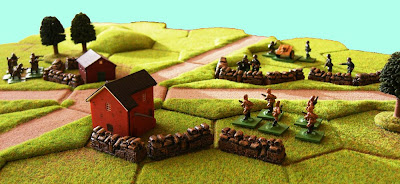The Russian plan was to mount a frontal attack with three infantry units (supported by the artillery), whilst the other two infantry units worked their way around the German right flank.
By the end of turn 5 the Russians had smashed through the German front-line, and were beginning to flank the second-line defences. The cost had, however, been high: the Russians had lost 37% of their infantry, and the remains of one infantry unit were falling back (there was no NKVD blocking detachment available to ‘encourage’ them to return to the fight!).
By the end of turn 7, the battle was over. The Russian flank attack enfiladed the German second-line defences just as their main attack reached it. The result was carnage. The Germans were over-run, and wiped out to a man. The Germans had continued to throw very low dice scores whilst the Russians had not. In the end the Russian casualties were 45% of their original strength. A Russian victory, but bought at a high price in terms of fighting men.
Lessons learned:
The rules are fun, and once one gets going they are simple to use.
The rule that makes opposing forces throw a D6 to decide who fires first makes perfect sense once one starts to use it. In the play-test game this should have meant that the Germans ought to have repulsed the Russian attacks quite easily and at very little cost to themselves; the fact that they did not is indicative as to how bad their dice throws were!
The use of playing cards to ‘activate’ units – a mechanism used in the original version of Red Flags and Iron Crosses – makes playing solo games very easy as the cards determine the order in which units move and fight and not the player’s (un)biased decisions.
Saving throws make sense if - as in this case - the rules mechanisms make it relatively easy to ‘hit enemy units.


















.JPG)















No comments:
Post a Comment
Thank you for leaving a comment. Please note that any comments that are spam or contain phishing messages or that come from Google Accounts that are 'Unknown' will be deleted.